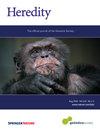Local adaptation has a role in reducing vulnerability to climate change in a widespread Amazonian forest lizard
IF 3.9
2区 生物学
Q2 ECOLOGY
引用次数: 0
Abstract
The extant genetic variation within and among taxa reflects a long history of diversification and adaptive mechanisms in response to climate change and landscape alterations. However, the velocity of current anthropogenic changes poses an imminent threat to global biodiversity. Understanding how species and populations might respond to global climate change provides valuable information for conservation in the face of these impacts. Here, we use genomic data to observe candidate loci under climate selection and test for genetic vulnerability to climate change in a widespread Amazonian ombrophilous lizard population. We found nine populations across Amazonia with a considerable amount of admixture among them. Distinct approaches of genome-environment association analyses revealed 56 candidate single-nucleotide polymorphisms (SNPs) under climatic selection, showing an east–west gradient in the adaptive landscape and a signal of local climate adaptation across the species range. According to our results, signals of local adaptation indicate that the species may not respond equally throughout its range, with some populations facing higher extinction risks. Genomic offset analysis predicts the southern and central portions of Amazonia to have a higher vulnerability to future climate change. Our findings highlight the importance of considering spatially explicit contexts with a large sampling coverage to evaluate how local adaptation and climatic vulnerability affect Amazonian forest ectothermic fauna.

在广泛分布的亚马逊森林蜥蜴中,当地适应在减少对气候变化的脆弱性方面发挥了作用。
现存的分类群内部和分类群之间的遗传变异反映了长期的多样化历史和对气候变化和景观变化的适应机制。然而,当前人为变化的速度对全球生物多样性构成了迫在眉睫的威胁。了解物种和种群如何应对全球气候变化,为面对这些影响的保护提供了有价值的信息。在这里,我们利用基因组数据观察了气候选择下的候选位点,并测试了广泛分布的亚马逊穴居蜥蜴种群对气候变化的遗传脆弱性。我们在亚马逊地区发现了9个种群,它们之间有相当数量的混合。不同的基因组-环境关联分析方法揭示了气候选择下56个候选单核苷酸多态性(snp),显示了适应性景观的东西梯度和物种范围内局部气候适应的信号。根据我们的研究结果,局部适应的信号表明,物种可能不会在其整个范围内做出相同的反应,一些种群面临更高的灭绝风险。基因组偏移分析预测,亚马逊南部和中部地区对未来气候变化的脆弱性更高。我们的研究结果强调了考虑具有大采样覆盖率的空间明确背景的重要性,以评估当地适应和气候脆弱性如何影响亚马逊森林变温动物。
本文章由计算机程序翻译,如有差异,请以英文原文为准。
求助全文
约1分钟内获得全文
求助全文
来源期刊

Heredity
生物-进化生物学
CiteScore
7.50
自引率
2.60%
发文量
84
审稿时长
4-8 weeks
期刊介绍:
Heredity is the official journal of the Genetics Society. It covers a broad range of topics within the field of genetics and therefore papers must address conceptual or applied issues of interest to the journal''s wide readership
 求助内容:
求助内容: 应助结果提醒方式:
应助结果提醒方式:


